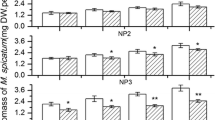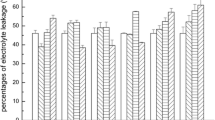Abstract
To reveal the mechanism of submerged plants decline in progressively eutrophicated freshwaters, physiological responses of Vallisneria natans to epiphytic algae were studied in simulation lab by measuring plant physiological indexes of chlorophyll content, malondialdehyde (MDA) content, and superoxide dismutase (SOD) activity based on a 2 × 4 factorial design with two epiphytic conditions (with epiphytic algae and without) and four levels of N and P concentrations in water (N-P[mg.L−1]: 0.5, 0.05; 2.5, 0.25; 4.5, 0.45; 12.5, 1.25). Compared with control (non-presence of epiphytic algae), chlorophyll contents of V. natans were significantly decreased (p < 0.01) for the presence of epiphytic algae under any concentrations of N and P in water bodies. While the presence of epiphytic algae induced peroxidation of membrane lipids, MDA contents of V. natans had significantly increased (p < 0.05) by comparing with control. SOD activity significantly enhanced (p < 0.05) with the presence of epiphytic algae in the treatments of T2 and T3 in the whole culture process by comparing with control, sometimes reaching an extremely significant level (p < 0.01). However, in the treatments of T1 and T4, SOD activity had no obvious change with the presence of epiphytic algae (p < 0.05) by comparing with control. At the end of the experiment, the effects of epiphytic algae on chlorophyll content and SOD activity in the leaves of V. natans were increased at first and then decreased with the concentrations of N and P in water, and MDA content became higher with the increase of N and P. concentrations. Repeated measurement data testing showed that the effects of epiphytic algae on the chlorophyll content and MDA content and SOD activity were significant, respectively (p < 0.001), the effects of epiphytic algae were combining with effects of concentrations of N and P (p < 0.001), respectively, and their interaction (p < 0.001). Our observations confirmed that this prediction: the growth of epiphytic algae directly produced adverse effects on physiology of V. natans and epiphytic algal biomass were positively correlated with nutrient available in the water column.





Similar content being viewed by others
Explore related subjects
Discover the latest articles and news from researchers in related subjects, suggested using machine learning.References
Asaeda T, Sultana M, Manatunge J, Fujino T (2004) The effect of epiphytic algae on the growth and production of Potamogeton perfoliatus L. in two light conditions. Environ Exp Bot 52:225–238
Bayley SE, Prather CM (2003) Do wetland lakes exhibit alternative stable states? Submersed aquatic vegetation and chlorophyll in western boreal shallow lakes. Limnol Oceanogr 48:2335–2345
Best EPH (1980) Effects of nitrogen on the growth and nitrogenous compounds of Ceratophyllum demersum. Aquat Bot 8:l97–l206
Brandt LE, Koch EW (2003) Periphyton as a UV-B filter on seagrass leaves: a result of different transmittance in UV-B and PAR. Aquat Bot 76:317–327
Burkholder JM, Mason KM, Glasgow HB (1992) Water column nitrate enrichment promotes decline of eelgrass Zostera marina: evidence from seasonal mesocosm experiments. Mar Ecol Prog Ser 81:163–178
Burkholder JM, Wetzel RQ (1990) Epiphytic alkaline phosphatase on natural and artificial plants in an oligotrophic lake: reevaluation of the role of macrophytes as a phosphorus source for epiphytes. Limnol Oceanogr 35:736–747
Cao T, Xie P, Ni LY, Wu AP, Zhang M, Wu SK, Smolders AJP (2007) The role of NH4 + toxicity in the decline of the submersed macrophyte Vallisneria natans in lakes of the Yangtze River basin, China. Mar Freshw Res 58:581–587
Chen C, Yin DQ, Yu B, Zhu HK (2007) Effect of epiphytic algae on photosynthetic function of Potamogeton crispus. J Freshw Ecol 22:411–420
Goldsborough LG, McDougal RL, North AK (2005) Periphyton in freshwater lakes and wetlands. In: Azim ME, Verdegem MCJ, van Dam AA, Beveridge M (eds) Periphyton: ecology, exploitation and management. CABI Publishing, London, pp 71–89
Gross EM, Feldbaum C, Graf A (2003) Epiphyte biomass and elemental composition on submersed macrophytes in shallow eutrophic lakes. Hydrobiologia 506:559–565
Havens KE, East TL, Rodusky AJ, Sharfstein B (1999) Littoral periphyton responses to nitrogen and phosphorus: an experimental study in a subtropical lake. Aquat Bot 63:267–290
Hough RA, Fomwall MD, Negele BJ, Thompson RL, Putt DA (1989) Plant community dynamics in a chain of lakes: principal factors in the dedine of rooted macrophytes with eutrophication. Hydrobiologia 173:199–217
Hu HJ, Li RY, Wei YX, Zhu HZ, Chen JY, Shi ZX (1980) Freshwater algae in China. Shanghai Science and Technology Press, Shanghai
Jeppesen E, Jensen JP, Kristensen P, Sondergaard M, Mortensen E, Sortkjaer O, Olrik K (1990) Fish manipulation as a lake restoration tool in shallow, eutrophic, temperate lakes 2: threshold levels, long-term stability and conclusions. Hydrobiologia 200/201:219–227
Jin XC, Tu QY (1990) The standard methods in lake eutrophication investigation. China Environmental Science Press, Beijing
Jones JI, Eaton JW, Hardwick K (2000) The influence of periphyton on boundary layer conditions: a pH microelectrode investigation. Aquat Bot 67:191–206
Jones JI, Young JO, Eaton JW, Moss B (2002) The influence of nutrient loading, dissolved inorganic carbon and higher tropic levels on the interaction between submerged plants and periphyton. J Ecol 90:12–24
Laugaste R, Lessok K (2004) Planktonic algae and epiphyton of the littoral in Lake Peipsi, Estonia. Limnologica 34:90–97
Li HS, Sun Q (2000) The experiment principle and technology of plant physiology. Higher Education Press, Beijing
Li W, Zhang Z, Jeppesen E (2008) The response of Vallisneria spinulosa (Hydrocharitaceae) to different loadings of ammonia and nitrate at moderate phosphorus concentration: a mesocosm approach. Freshw Biol 53:2321–2330
Liu LZ, Qin BQ, Zhu GW, Song YZ, Wang XD, Ding YQ (2012) Effect of decomposition products of cyanobacteria on Myriophyllum spicatum and water quality in Lake Taihu, China. Acta Ecol Sin 32:3154–3159
Loftus MC, Carpenter JH (1971) A fluoremetric method for determining chlorophylls a, b and c. J Mar Res 29:319–338
Neckles HA, Wetzel RL, Orth RJ (1993) Relative effects of nutrient enrichment and grazing on epiphyte-macrophyte (Zostera marina L.) dynamics. Oecologia 93:285–295
Ni LY (2001) Effects of water column nutrient enrichment on the growth of Potamogeton rnaackianus A. Been. J Aquat Plant Manag 39:83–87
Nimptsch J, Pflugmacher S (2007) Ammonia triggers the promotion of oxidative stress in the aquatic macrophyte Myriophyllum mattogrossense. Chemosphere 66:708–714
Orth RJ, Carruthers TJB, Dennison WC, Duarte CM, Fourqurean JW, Heck KL Jr, Hughes AR, Kendrick GA, Kenworthy WJ, Olyarnik S, Short FT, Waycott M, Williams SL (2006) A global crisis for seagrass ecosystems. Bioscience 56:987–996
Phillips GL, Eminson D, Moss B (1978) A mechanism to account for macrophyte decline in progressively eutrophicated freshwaters. Aquat Bot 4:103–126
Qin BQ, Gao G, Zhu GW, Zhang YL, Song YZ, Tang XM, Xu H, Deng JM (2013) Lake eutrophication and its ecosystem response. Chin Sci Bull 58:961–970
Qin BQ, Song YZ, Gao G (2006) The role of periphytes in the shift between macrophyte and phytoplankton dominated systems in a shallow eutrophic lake Lake Taihu, China. Sci China Ser C 49:597–602
Rao GG, Rao GR (1981) Pigment composition and chlorophyyase activity in pigment pea and Gingelley under NACL salinity. Indian J Exp Biol 19:768–770
Roberts E, Kroker J, Koerner S, Nicklisch A (2003) The role of periphyton during the re-colonization of a shallow lake with submerged macrophytes. Hydrobiologia 506/509:525–530
Sand-Jensen K (1990) Epiphyte shading: its role in resulting depth distribution of submerged aquatic macrophytes. Folia Geobotanica 25:315–320
Scheffer M (1998) Ecology of shallow lakes. Chapman and Hall, London, p 357
Sheng H, Liu H, Wang C, Guo H, Liu Y, Yang Y (2012) Analysis of cyanobacteria bloom in the Waihai part of Dianchi Lake, China. Ecol Inform 10:37–48
Smoot JC, Langworthy DE, Levy M, Findlay RH (1998) Periphyton growth on submerged artificial substrate as a predictor of phytoplankton response to nutrient enrichment. J Microbiol Methods 32:11–19
Song YZ, Huang J, Qin BQ (2010) Effects of epiphyte on the rapid light curves of two submerged macrophytes in Lake Taihu. J Lake Sci 22:935–940
Su SQ, Zhou YM, Qin JG, Wang W, Yao WZ, Song L (2012) Physiological responses of Egeria densa to high ammonium concentration and nitrogen deficiency. Chemosphere 86:538–545
Sultana M, Asaeda T, Azim ME, Fujino T (2010) Morphological responses of a submerged macrophyte to epiphyton. Aquat Ecol 44:73–81
Vermaat JE, Santamaria L, Roos PJ (2000) Water flow across and sediment trapping in submerged macrophyte beds of contrasting growth form. Arch Hydrobiol 148:549–562
Wang C, Zhang SH, Wang PF, Hou J, Li W, Zhang WJ (2008) Metabolic adaptations to ammonia-induced oxidative stress in leaves of the submerged macrophyte Vallisneria natans (Lour.) Hara. Aquat Toxicol 87:88–98
Wang XD, Qin BQ, Gao G, Yang GJ, Wang HY, Song YZ, Feng S (2009) Endurance of Elodea nuttallii to high concentration of nitrogen and phosphorus. Chin J Ecol 28:2561–2566
Wu WH (2012) Plant physiology, 2nd edn. Science Press, Beijing
Zaman T, Asaeda T (2013) Effects of NH4–N concentrations and gradient redox level on growth and allied biochemical parameters of Elodea nuttallii (Planch.). Flora Morphol Distrib Funct Ecol Plants 208:211–219
Zhu W, Zhang LF, Cao JS, Wan L, Mei XM (2006) Experimental research on growth of Potamageton crispus and Elodea nuttallii under different polluted water. Water Resour Protect 22:36–39
Acknowledgments
We are grateful to Min Wang and Shu-Ying Zhao for their help in the experiment. We also thank Dr. Guang Gao for his linguistic improvements. The research was financially supported by the National Science Foundation of China (project no.41471446)
Author information
Authors and Affiliations
Corresponding author
Additional information
Responsible editor: Philippe Garrigues
Rights and permissions
About this article
Cite this article
Song, YZ., Wang, JQ., Gao, YX. et al. The physiological responses of Vallisneria natans to epiphytic algae with the increase of N and P concentrations in water bodies. Environ Sci Pollut Res 22, 8480–8487 (2015). https://doi.org/10.1007/s11356-014-3998-x
Received:
Accepted:
Published:
Issue Date:
DOI: https://doi.org/10.1007/s11356-014-3998-x




